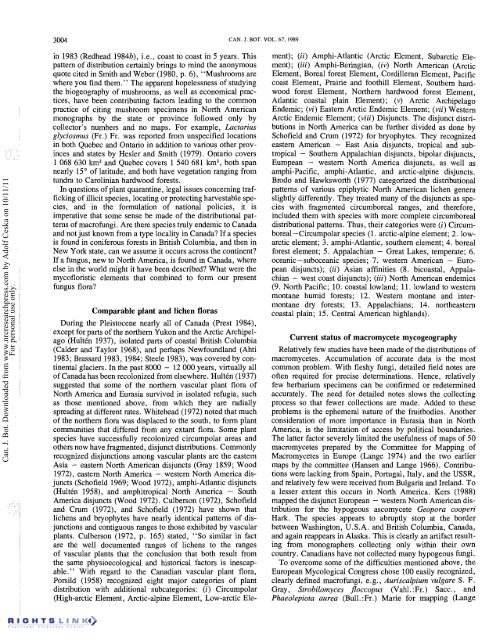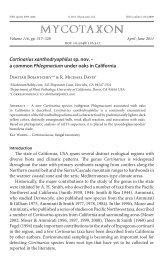Redhead Fungal Biogeography.pdf - Mushroom Hobby
Redhead Fungal Biogeography.pdf - Mushroom Hobby
Redhead Fungal Biogeography.pdf - Mushroom Hobby
You also want an ePaper? Increase the reach of your titles
YUMPU automatically turns print PDFs into web optimized ePapers that Google loves.
Can. J. Bot. Downloaded from www.nrcresearchpress.com by Adolf Ceska on 10/11/11<br />
For personal use only.<br />
3004 CAN. J. BOT. \<br />
in 1983 (<strong>Redhead</strong> 1984b), i.e., coast to coast in 5 years. This<br />
pattern of distribution certainly brings to mind the anonymous<br />
quote cited in Smith and Weber (1980, p. 6), "<strong>Mushroom</strong>s are<br />
where you find them." The apparent hopelessness of studying<br />
the biogeography of mushrooms, as well as economical practices,<br />
have been contributing factors leading to the common<br />
practice of citing mushroom specimens in North American<br />
monographs by the state or province followed only by<br />
collector's numbers and no maps. For example, Lactarius<br />
glyciosmus (Fr.) Fr. was reported from unspecified locations<br />
in both Quebec and Ontario in addition to various other provinces<br />
and states by Hesler and Smith (1979). Ontario covers<br />
1 068 630 km2 and Quebec covers 1 540 681 km2, both span<br />
nearly 15" of latitude, and both have vegetation ranging from<br />
tundra to Carolinian hardwood forests.<br />
In questions of plant quarantine, legal issues concerning trafficking<br />
of illicit species, locating or protecting harvestable species,<br />
and in the formulation of national policies, it is<br />
imperative that some sense be made of the distributional patterns<br />
of macrofungi. Are there species truly endemic to Canada<br />
and not just known from a type locality in Canada? If a species<br />
is found in coniferous forests in British Columbia, and then in<br />
New York state, can we assume it occurs across the continent?<br />
If a fungus, new to North America, is found in Canada, where<br />
else in the world might it have been described? What were the<br />
mycofloristic elements that combined to form our present<br />
fungus flora?<br />
Comparable plant and lichen floras<br />
During the Pleistocene nearly all of Canada (Prest 1984),<br />
except for parts of the northern Yukon and the Arctic Archipel-<br />
ago (HultCn 1937), isolated parts of coastal British Columbia<br />
(Calder and Taylor 1968), and perhaps Newfoundland (Ahti<br />
1983; Brassard 1983, 1984; Steele 1983), was covered by con-<br />
tinental glaciers. In the past 8000 - 12 000 years, virtually all<br />
of Canada has been recolonized from elsewhere. HultCn (1937)<br />
suggested that some of the northern vascular plant flora of<br />
North America and Eurasia survived in isolated refugia, such<br />
as those mentioned above, from which they are radially<br />
spreading at different rates. Whitehead (1972) noted that much<br />
of the northern flora was displaced to the south, to form plant<br />
communities that differed from any extant flora. Some plant<br />
species have successfully recolonized circumpolar areas and<br />
others now have fragmented, disjunct distributions. Commonly<br />
recognized disjunctions among vascular plants are the eastern<br />
Asia - eastern North American disjuncts (Gray 1859; Wood<br />
1972), eastern North America - western North America dis-<br />
juncts (Schofield 1969; Wood 1972), amphi-Atlantic disjuncts<br />
(HultCn 1958), and amphitropical North America - South<br />
America disjuncts (Wood 1972). Culberson (1972), Schofield<br />
and Crum (1972), and Schofield (1972) have shown that<br />
lichens and bryophytes have nearly identical patterns of dis-<br />
junctions and contiguous ranges to those exhibited by vascular<br />
plants. Culberson (1972, p. 165) stated, "So similar in fact<br />
are the well documented ranges of lichens to the ranges<br />
of vascular plants that the conclusion that both result from<br />
the same physioecological and historical factors is inescap-<br />
able." With regard to the Canadian vascular plant flora,<br />
Porsild (1958) recognized eight major categories of plant<br />
distribution with additional subcategories: (i) Circumpolar<br />
(High-arctic Element, Arctic-alpine Element, Low-arctic Ele-<br />
ment); (ii) Amphi-Atlantic (Arctic Element, Subarctic Ele-<br />
ment); (iii) Amphi-Beringian, (iv) North American (Arctic<br />
Element, Boreal forest Element, Cordilleran Element, Pacific<br />
coast Element, Prairie and foothill Element, Southern hard-<br />
wood forest Element, Northern hardwood forest Element,<br />
Atlantic coastal plain Element); (v) Arctic Archipelago<br />
Endemic; (vi) Eastern Arctic Endemic Element; (vii) Western<br />
Arctic Endemic Element; (viii) Disjuncts. The disjunct distri-<br />
butions in North America can be further divided as done by<br />
Schofield and Crum (1972) for bryophytes. They recognized<br />
eastern American - East Asia disjuncts, tropical and sub-<br />
tropical - Southern Appalachian disjuncts, bipolar disjuncts,<br />
European - western North America disjuncts, as well as<br />
amphi-Pacific, amphi-Atlantic, and arctic-alpine disjuncts.<br />
Brodo and Hawksworth (1977) categorized the distributional<br />
patterns of various epiphytic North American lichen genera<br />
slightly differently. They treated many of the disjuncts as spe-<br />
cies with fragmented circumboreal ranges, and therefore,<br />
included them with species with more complete circumboreal<br />
distributional patterns. Thus, their categories were (i) Circum-<br />
boreal -Circumpolar species (1. arctic-alpine element; 2. low-<br />
arctic element; 3. amphi-Atlantic, southern element; 4. boreal<br />
forest element; 5. Appalachian - Great Lakes, temperate; 6.<br />
oceanic-suboceanic species; 7. western American - Euro-<br />
pean disjuncts); (ii) Asian affinities (8. bicoastal, Appala-<br />
chian - west coast disjuncts); (iii) North American endemics<br />
(9. North Pacific; 10. coastal lowland; 11. lowland to western<br />
montane humid forests; 12. Western montane and inter-<br />
montane dry forests; 13. Appalachians; 14. northeastern<br />
coastal plain; 15. Central American highlands).<br />
Current status of macromycete mycogeography<br />
Relatively few studies have been made of the distributions of<br />
macromycetes. Accumulation of accurate data is the most<br />
common problem. With fleshy fungi, detailed field notes are<br />
often required for precise determinations. Hence, relatively<br />
few herbarium specimens can be confirmed or redetermined<br />
accurately. The need for detailed notes slows the collecting<br />
process so that fewer collections are made. Added to these<br />
problems is the ephemeral nature of the fruitbodies. Another<br />
consideration of more importance in Eurasia than in North<br />
America, is the limitation of access by political boundaries.<br />
The latter factor severely limited the usefulness of maps of 50<br />
macromycetes prepared by the Committee for Mapping of<br />
Macromycetes in Europe (Lange 1974) and the two earlier<br />
maps by the committee- a an sen and Lange 1966). Contribu-<br />
tions were lacking from Spain, Portugal, Italy, and the USSR,<br />
and relatively few were received from Bulgaria and Ireland. To<br />
a lesser extent this occurs in North America. Kers (1988)<br />
mapped the disjunct European - western North American dis-<br />
tribution for the hypogeous ascomycete Geopora cooperi<br />
Hark. The species appears to abruptly stop at the border<br />
between Washington, U.S.A. and British Columbia, Canada,<br />
and again reappears in Alaska. This is clearly an artifact result-<br />
ing from monographers collecting only within their own<br />
country. Canadians have not collected many hypogeous fungi.<br />
To overcome some of the difficulties mentioned above, the<br />
European Mycological Congress chose 100 easily recognized,<br />
clearly defined macrofungi, e.g., Auriscalpium vulgare S. F.<br />
Gray, Strobilomyces floccopus (Vahl. : Fr.) Sacc., and<br />
Phaeolepiota aurea (Bull. : Fr .) Marie for mapping (Lange



